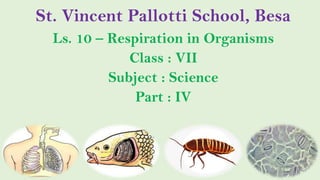
Respiration in Organisms Part 411111111111111111111.pdf
- 1. St. Vincent Pallotti School, Besa Ls. 10 – Respiration in Organisms Class : VII Subject : Science Part : IV
- 2. In Part IV, you will learn about – Breathing and Respiration in other animals Respiration in plants
- 3. Breathing in Earthworm • The earthworm breathes through its skin. • The skin of earthworm is quite thin and moist. • Gases can easily pass through the skin of earthworm. • The carbon dioxide produced during respiration is carried back by the blood. This carbon dioxide is expelled from the body of the earthworm through its skin. Thus, in earthworm the exchange of gases takes place through the thin and moist skin. • So, the earthworm absorbs the oxygen (of air) needed for respiration through its thin and moist skin. This oxygen is then transported to all the cells of the earthworm by its blood where it is used in respiration (production of energy).
- 4. Frogs live on land as well as in water. Though frogs have lungs for breathing, they can also breathe through their moist skin. Thus, frog is an animal which can breathe through lungs as well as its moist skin. The frog breathes through the lungs as well as through skin.
- 5. Breathing in Fish • The fish breathes by taking in water through its mouth and sending it over the gills. • When water passes over the gills, the gills absorb the dissolved oxygen from this water. Fish lives in water. The fish has special organs of breathing called 'gills'. The gills help the fish to use oxygen which is dissolved in water (in which it lives). The gills are covered by gill covers so they are not visible from outside. • The extracted oxygen is absorbed by the blood and carried to all the parts of the fish for respiration (release of energy. The carbon dioxide produced during respiration is brought back by the blood into the gills for expelling int the surrounding water. Gills This happens as follows:
- 6. Breathing in Insects • Air (rich in oxygen) enters into the insect through spiracles by the up and down movements of its body. • This air goes into the network of thin air-tubes called tracheae. From the tracheae, oxygen of air diffuses into the body tissues of insect and reaches each and every cell of its body where it is utilised in respiration (production of energy). • Carbon dioxide produced during respiration in the cells diffuses into tracheae and carried to the spiracles where it is expelled in the process of breathing. Thus, in insects the exchange of gases occurs through tracheae. All the insects have tiny holes on the sides of their body which are called spiracles. The spiracles on the body of insects are connected to a network of thin air-tubes called tracheae which spread into the whole body of the insect. The breathing in all the insects takes place through spiracles and tracheae. This happens as follows:
- 7. Respiration in Plants The plants get energy by the process of respiration in which food breaks down in the presence of oxygen to form carbon dioxide and water with the release of energy. This energy is used by the plant for carrying out its various life processes. Respiration in plants is carried out by leaves and roots independently.
- 8. Respiration in Leaves The leaves of plants have tiny pores on their surface which are called stomata. The exchange of gases (oxygen and carbon dioxide) the leaves during respiration takes place through stomata. • Oxygen from air enters into a leaf through stomata and reaches in all the cells by the process of diffusion. • This oxygen is used in respiration in the cells of the leaf. • The carbon dioxide produced during respiration diffuses out from the leaf into air through the same stomata. This happens as follows:
- 9. Respiration in Roots The roots of a plant are under the ground but root cells also need oxygen. The roots obtain oxygen for breathing and respiration from the soil as follows: • Air is present in-between the particles of soil. The roots of a plant take up air from the spaces between the soil particles. • The roots of a plant have a very large number of tiny hair on them which are called 'root hair'. The root hair are in contact with the air in the soil particles. • Oxygen from air in soil particles diffuses into root hair and reaches all the cells of the root where it is utilised in respiration. • Carbon dioxide produced in the cells of the root during respiration goes out through the same root hair by the process of diffusion. • Thus, the respiration in roots occurs by the exchange of gases (oxygen and carbon dioxide) through the root hair.
- 10. Think and Answer Three test-tubes are taken and labelled A, B and C. Each test-tube is half filled with water. (a) In test-tube A, a snail is kept. (b) In test-tube B, a water plant is kept and (c) In test-tube C, a snail and a water plant, both are kept. The three test-tubes are then placed in sunlight. Which test-tube would have the highest concentration of carbon dioxide ? Why?